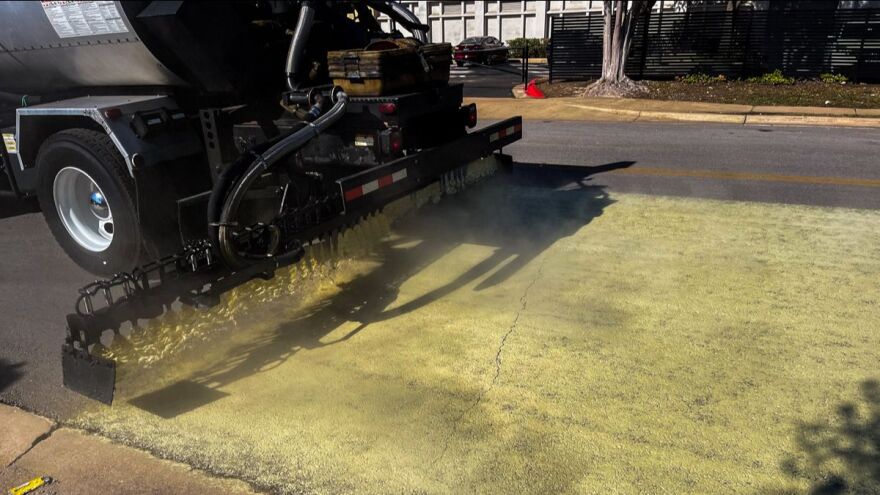Austin roads are taking a beating this summer. An extended heat wave that could be the most severe on record is warping highways and cracking streets. But the pavement is shriveling so slowly, it can be hard to notice.
One of the most catastrophic — and fortunately, most rare — road failures blamed on heat is called buckling. That's when road segments expand into each other and push up, creating dangerous speed bumps on the highway.
"When it gets really hot, especially when you have heat over many, many days or weeks as we've seen here lately, we usually see that at the pavement joints," TxDOT spokesperson Brad Wheelis said.
No buckling has been reported this summer on state highways in TxDOT's 11-county Austin district. But it has happened at least three times this summer in the Houston area.

"We don't see it a whole lot here in the Austin district," Wheelis said. "But in years past, that has been an issue."
Rutting and cracking
A more common problem, something you may have seen, is called rutting. That's when the asphalt gets so hot, it actually softens. Heavy vehicles can push against the asphalt almost like play-dough, creating ripples in the pavement.
"Basically, if you're driving down the road, you'll see what might look like grooves or tire areas, a little dip," Wheelis said. Rutting is most common at intersections or where the road turns.

Rutting can be dangerous if the grooves pull your tires in a different direction. When it rains, the ruts fill up with water, increasing the odds of hydroplaning.
Major highways and busy roads are most susceptible to rutting because they have the most traffic and the heaviest vehicles.
But side streets can also crisp up in the relentless heat.
"Definitely there's a huge impact of this extended heat on our pavement network," said Veena Prabhakar, a pavement engineer with the City of Austin. "If you leave something out in the sun, it starts to dry up and it tends to get brittle and it cracks up."
As the oils in the asphalt evaporate, streets turn from black to gray. Austin's newly resurfaced roads are turning gray faster than they used to, leading to rougher rides and premature cracking.
"When that happens, water gets into our pavement structure, and water is the worst enemy of pavements," Prabhakar said, because water causes the pavement to break down and slowly disintegrate.

Some parts of the city have it worse than others. In East Austin, a clay-heavy soil underneath the roads shrinks as it dries out in the heat. When it rains, the clay expands, causing even more cracks on the pavement.
In 2011, the most severe summer on record, Austin had "lots of pavement failures," Prabhakar said. This year's summer is expected to be even hotter.
"We have more needs on the pavement network than we can afford to pay for," he said. "It's hard to quantify early on the long-term effects of climate change."
Inflation and worsening roads pushed Austin's preventive street maintenance budget 30% higher in the last three years to more than $30 million. Spending on street repair has remained relatively unchanged since 2020 at around $22 million a year.
But many of the city's streets are still in rough shape.
Austin uses vehicle-mounted lasers to grade the quality of city streets on a scale of A to F. Most are in excellent to acceptable shape. But about 16% of Austin's streets were graded D (moderately rough ride) and 10% were F (very rough ride).
Future innovations
Pavement researchers say many of the older asphalt formulations aren't working as well in cities like Austin where summers are becoming more intense. So cities have to adapt to new climate realities.
"It's not like tomorrow, all the roads are going to fail," said Shane Underwood, a professor and pavement expert at North Carolina State University. "It's that there's going to be more disruption little by little. It's like nickel and diming you to death."
Austin is taking some measures to protect roads from the heat. On certain busy streets, special chemicals are being added to asphalt that makes the surface resistant to a wider range of temperatures. But those high-performance chemicals are expensive, and the city expects to need a lot more in the coming years.
On a smaller scale, Austin is experimenting with cooling pavement by spraying streets with a chemical that includes titanium dioxide. A $17,000 pilot project is being done on a short stretch of Meinardus Drive just southeast of I-35 and Ben White.

Treating streets with the lighter-colored seal helped to reduce the asphalt temperature by up to 10 degrees, said Dev Niyogi, a UT professor who directs the Texas Extreme Weather and Urban Sustainability Lab and was involved in the project.
But Niyogi isn't just concerned about cooling roads. He's also worried about the temperatures in the neighborhoods that surround them.
"The effects go far beyond what happens just on the road surface and quickly gets into communities," he said.
"Think about the roads being the arteries and veins of a city," he said. "When you have every bit of that road hotter than the surrounding parks or open streets, then you're going to have a much warmer body, and that's what is our city."
Austin has applied for a federal grant to expand the cool pavement pilot project. An award announcement is expected in September.
Even as the city works to combat the heat's impact on its streets, the road network keeps expanding each year. The region's high housing costs are driving development farther out, intensifying dependence on roads and cars.
All those vehicles are contributing to the problem, and it's not just tailpipes and engine blocks blasting out heat.
Cars and trucks account for about a quarter of greenhouse gas emissions in the United States, trapping even more heat in the atmosphere and putting a bigger strain on the roads we rely on to get around.















